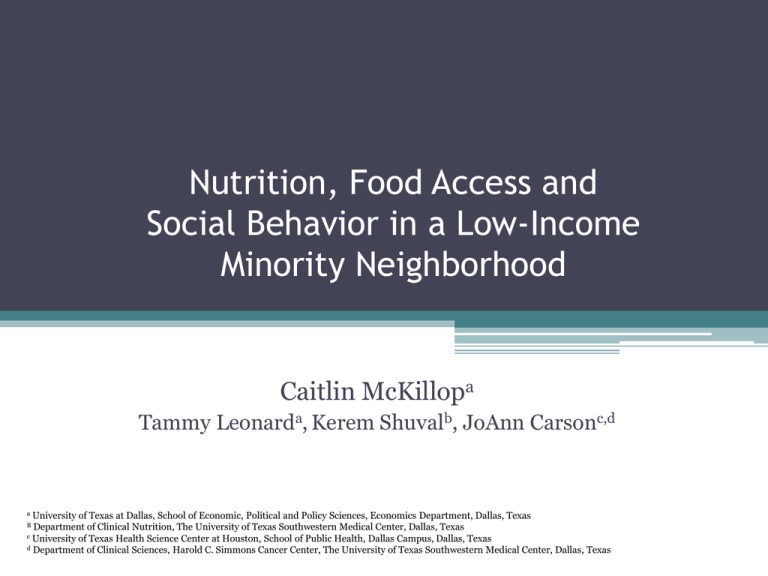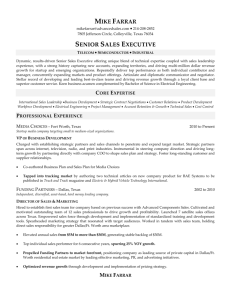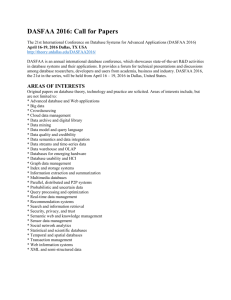Nutrition, Food Access and Social Behavior in a Low
advertisement

Nutrition, Food Access and Social Behavior in a Low-Income Minority Neighborhood Caitlin McKillopa Tammy Leonarda, Kerem Shuvalb, JoAnn Carsonc,d a University of Texas at Dallas, School of Economic, Political and Policy Sciences, Economics Department, Dallas, Texas Department of Clinical Nutrition, The University of Texas Southwestern Medical Center, Dallas, Texas c University of Texas Health Science Center at Houston, School of Public Health, Dallas Campus, Dallas, Texas d Department of Clinical Sciences, Harold C. Simmons Cancer Center, The University of Texas Southwestern Medical Center, Dallas, Texas B The Importance of Good Nutrition The Facts The Group Trends • Poor nutrition linked to an increased risk of obesity, cancer and cardiovascular disease • Higher prevalence of obesity among minorities and low-income households • Two out of every three adults in the US were obese or overweight in 2010 • Low SES individuals are more likely to live in neighborhoods with a lower occurrence of healthy food alternatives • Clustering of high BMI or obese individuals across space The Research Landscape • A significant amount of attention has been given to studying the dietary implications of living in a food desert, or a neighborhood where healthy, affordable food is difficult to obtain However, the literature suggests that access to healthy foods alone is not a main cause of poor nutrition • Recent studies suggest the presence and significance of peer effects in nutrition outcomes Being part of social group where other members recently gained weight might influence an individual to adopt similar behaviors Research Question Purpose To examine the dual role of the social and physical environment as they relate to the eating behaviors of individuals living in a low-income minority neighborhood that is classified as a food desert NCI Multifactor Screener Data Measures • Pyramid servings of Fruits & Vegetables (excluding French fries) • Percent of energy from Fat • Grams of Fiber consumed Measuring the Influence of Food Consumption Determinants Consumption of Peers Social Network Characteristics c Wc x N D Food Consumption Individual Characteristics Degree of Access to Food Options Results Perceptions • Individuals who perceived food sources in a food desert neighborhood as adequate consumed an average of 4.5% more calories from fat per day Network Characteristics • Individuals with friends who exercised ate an extra 1/3 additional serving of vegetables per day Geographic Peers • Individuals whose social contacts also resided in the same food desert environment consumed on average 7.5% more calories from fat per day Access • While living closer to fresh food sources or food pantries was related to increased fruit & vegetable consumption, both effects disappeared entirely when peer effects were added • However, respondents living closer to fast food sources still incorporated fewer fruits & vegetables into their diet Significance • Despite recent studies suggesting that access may not be a factor in dietary decisions, we find that it does play a role ▫ ¼ mile closer to a pantry: Increase in daily fruit & vegetable consumption by ¼ serving ▫ ¼ mile closer to a fast food restaurant: Decrease in daily fruit & vegetable consumption by ¼ serving • Perhaps chain grocery stores (usual focus when considering access) should not be of prime importance ▫ Dual existence of commercial and charitable food sources ▫ Targeting transmission of social norms through peer networks to improve attitudes and behaviors towards consuming healthier foods Policy and Intervention Design • Dual role of proximity and social influences in determining diet ▫ Reciprocal relationship between people and place • Marketing and education campaigns can be designed to address: ▫ Dietary norms ▫ Types of food provided by non-profit agencies ▫ Peer behaviors • Access improvement should be undertaken with a broad view of what constitutes access to healthy foods for populations most impacted by access-related challenges • Consideration of non-traditional food access points Conclusion In addition to highlighting the need to incorporate the dual role that non-profit and commercial sources likely play in healthy food sourcing, our results suggest the importance of considering neighborhood social dynamics when designing policy and interventions to more successfully modify nutrition behavior Thank You!











